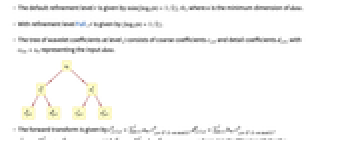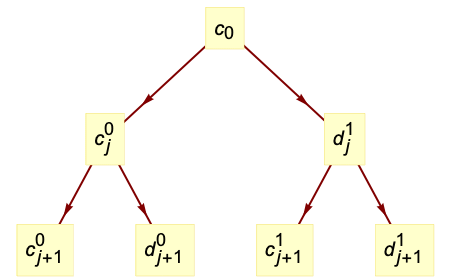StationaryWaveletPacketTransform[data]
gives the stationary wavelet packet transform (SWPT) of an array of data.
StationaryWaveletPacketTransform[data,wave]
gives the stationary wavelet packet transform using the wavelet wave.
StationaryWaveletPacketTransform[data,wave,r]
gives the stationary wavelet packet transform using r levels of refinement.




StationaryWaveletPacketTransform
StationaryWaveletPacketTransform[data]
gives the stationary wavelet packet transform (SWPT) of an array of data.
StationaryWaveletPacketTransform[data,wave]
gives the stationary wavelet packet transform using the wavelet wave.
StationaryWaveletPacketTransform[data,wave,r]
gives the stationary wavelet packet transform using r levels of refinement.
Details and Options



- StationaryWaveletPacketTransform is a generalization of StationaryWaveletTransform where the full tree of wavelet coefficients is computed.
- StationaryWaveletPacketTransform gives a DiscreteWaveletData object.
- Properties of the DiscreteWaveletData dwd can be found using dwd["prop"], and a list of available properties can be found using dwd["Properties"].
- The resulting wavelet coefficients are arrays of the same depth and dimensions as the input data.
- The data can be any of the following:
-
list arbitrary-rank numerical array image arbitrary Image object audio an Audio or sampled Sound object - The possible wavelets wave include:
-
BattleLemarieWavelet[…] Battle–Lemarié wavelets based on B-spline BiorthogonalSplineWavelet[…] B-spline-based wavelet CoifletWavelet[…] symmetric variant of Daubechies wavelets DaubechiesWavelet[…] the Daubechies wavelets HaarWavelet[…] classic Haar wavelet MeyerWavelet[…] wavelet defined in the frequency domain ReverseBiorthogonalSplineWavelet[…] B-spline-based wavelet (reverse dual and primal) ShannonWavelet[…] sinc function-based wavelet SymletWavelet[…] least asymmetric orthogonal wavelet - The default wave is HaarWavelet[].
- With higher settings for the refinement level r, larger scale features are resolved.
- The default refinement level r is given by
![min(TemplateBox[{{{InterpretationBox[{log, _, DocumentationBuild`Utils`Private`Parenth[2]}, Log2, AutoDelete -> True], (, n, )}, +, {1, /, 2}}}, Floor],4) min(TemplateBox[{{{InterpretationBox[{log, _, DocumentationBuild`Utils`Private`Parenth[2]}, Log2, AutoDelete -> True], (, n, )}, +, {1, /, 2}}}, Floor],4)](Files/StationaryWaveletPacketTransform.en/1.png) , where
, where  is the minimum dimension of data.
is the minimum dimension of data. - With refinement level Full, r is given by
![TemplateBox[{{{InterpretationBox[{log, _, DocumentationBuild`Utils`Private`Parenth[2]}, Log2, AutoDelete -> True], (, n, )}, +, {1, /, 2}}}, Floor] TemplateBox[{{{InterpretationBox[{log, _, DocumentationBuild`Utils`Private`Parenth[2]}, Log2, AutoDelete -> True], (, n, )}, +, {1, /, 2}}}, Floor]](Files/StationaryWaveletPacketTransform.en/3.png) .
. - The tree of wavelet coefficients at level
 consists of coarse coefficients
consists of coarse coefficients  and detail coefficients
and detail coefficients  , with
, with  representing the input data.
representing the input data. - The forward transform is given by
 ,
,  ,
,  , and
, and  , where
, where  is the filter length for the corresponding wspec and
is the filter length for the corresponding wspec and  is the length of input data.
is the length of input data. - The inverse transform is given by
 .
. - The
 are lowpass filter coefficients and
are lowpass filter coefficients and  are highpass filter coefficients that are defined for each wavelet family.
are highpass filter coefficients that are defined for each wavelet family. - The following options can be given:
-
Method Automatic method to use WorkingPrecision MachinePrecision precision to use in internal computations - StationaryWaveletPacketTransform uses periodic padding of data.
- InverseWaveletTransform gives the inverse transform.
- By default, InverseWaveletTransform uses coefficients represented by dwd["BasisIndex"] for reconstruction. Use WaveletBestBasis to compute and set an optimal basis.

Examples
open all close allBasic Examples (3)
Compute a stationary wavelet packet transform:
The resulting DiscreteWaveletData represents a full tree of wavelet coefficients:
The inverse transform reconstructs the input:
Use dwd[…,"Audio"] to extract coefficient signals:
Compute the inverse transform:
Transform an Image object:
Scope (33)
Basic Uses (4)
Useful properties can be extracted from the DiscreteWaveletData object:
Get a full list of properties:
Get data and coefficient dimensions:
Use Normal to get all wavelet coefficients explicitly:
Also use All as an argument to get all coefficients:
Use Automatic to get only the coefficients used in the inverse transform:
Use the "TreeView" or "WaveletIndex" to find out what wavelet coefficients are available:
Extract specific coefficient arrays:
Extract several wavelet coefficients corresponding to a list of wavelet index specifications:
Extract all coefficients whose wavelet indexes match a pattern:
Use a higher refinement level to increase the frequency resolution:
With a smaller refinement level, more of the signal energy is left in {0,0}:
With further refinement, {0,0} is resolved into further components:
Wavelet Families (10)
Compute the wavelet packet transform using different wavelet families:
Use different families of wavelets to capture different features:
HaarWavelet (default):
1-Dimensional Data (6)
Plot the coefficients over a common horizontal axis using WaveletListPlot:
Plot against a common vertical axis:
Visualize coefficients as a function of time and refinement level using WaveletScalogram:
The coefficient indexes appear as tooltips when the mouse pointer is moved over a coefficient:
All coefficients are small except coarse coefficients {0,0,…}:
Data oscillating at the highest resolvable frequency (Nyquist frequency):
Only the first detail coefficient {1} and its coarse child coefficients {1,0,0,…} are not small:
Data with large discontinuities:
Coarse coefficients {0,…} have the same large-scale structure as the data:
Detail coefficients are sensitive to discontinuities:
Data with both spatial and frequency structure:
Coarse coefficients {0,…} track the local mean of the data:
First detail coefficient {1} and its coarse child coefficients {1,0,…} represent the oscillations:
2-Dimensional Data (5)
Compute a two-dimensional stationary wavelet packet transform:
View the tree of wavelet coefficients:
Inverse transform to get back the original signal:
Use dwd[…,"MatrixPlot"] to visualize each coefficient as a MatrixPlot:
Visualize diagonal detail coefficient {3} and its child coefficients {3,__}:
In two dimensions, the vector of filtering operations in each direction can be computed:
Interpreting these vectors as binary digit expansions, you get wavelet index numbers:
Get the lowpass and highpass filters for a Haar wavelet:
The resulting 2D filters are outer products of filters in the two directions:
Wavelet transform of step data:
Data with a vertical discontinuity:
All horizontal and diagonal detail coefficients, wavelet index {___,2|3,___}, are zero:
Data with horizontal discontinuity:
All vertical and diagonal detail coefficients, wavelet index {___,1|3,___}, are zero:
Higher-Dimensional Data (2)
Compute a three-dimensional wavelet packet transform:
List all computed wavelet coefficients:
Inverse transform to get back the original signal:
Wavelet transform of a three-dimensional cross array:
Visualize lowpass wavelet coefficients {___,0}:
Energy of the original data is conserved within the transformed coefficients:
Audio Data (2)
Sound Data (2)
Image Data (2)
Transform an Image object:
The inverse transform yields a reconstructed Image object:
Wavelet coefficients are normally given as lists of data for each image channel:
Get all coefficients as Image objects instead:
Get raw Image objects with no rescaling of color levels:
Get the inverse transform of the {0,1} coefficient as an Image object:
Generalizations & Extensions (3)
StationaryWaveletPacketTransform works on arrays of symbolic quantities:
Inverse transform recovers the input exactly:
Options (3)
WorkingPrecision (3)
By default, WorkingPrecision->MachinePrecision is used:
Use higher-precision computation:
Use WorkingPrecision->∞ for exact computation:
Properties & Relations (10)
StationaryWaveletPacketTransform computes the full tree of wavelet coefficients:
StationaryWaveletTransform computes a subset of the full tree of coefficients:
DiscreteWaveletPacketTransform coefficients halve in length with each level of refinement:
Rotated data gives different coefficients:
StationaryWaveletPacketTransform coefficients have the same length as the data:
Rotated data gives rotated coefficients:
The default refinement is given by Min[Round[Log2[Min[Dimensions[data]]]],4]:
The energy norm is conserved for orthogonal wavelet families:
The energy norm is approximately conserved for biorthogonal wavelet families:
The mean of the data is captured at the maximum refinement level of the transform:
Extract the coefficient for the maximum refinement level:
The sum of inverse transforms from individual coefficient arrays gives the original data:
Individually inverse transform each wavelet coefficient array:
The sum gives the original data:
Compute a Haar stationary wavelet packet transform in one dimension:
Compute {0} and {1} wavelet coefficients:
Compare with StationaryWaveletPacketTransform:
In two dimensions, a separate filter is applied in each dimension:
Lowpass and highpass filters for Haar wavelet:
Haar wavelet transform of matrix data:
Compare with StationaryWaveletPacketTransform using HaarWavelet:
Image channels are transformed individually:
Combine {0} coefficients of separately transformed image channels:
Compare with {0} coefficient of StationaryWaveletPacketTransform of original image:
Related Guides
Text
Wolfram Research (2010), StationaryWaveletPacketTransform, Wolfram Language function, https://reference.wolfram.com/language/ref/StationaryWaveletPacketTransform.html (updated 2017).
CMS
Wolfram Language. 2010. "StationaryWaveletPacketTransform." Wolfram Language & System Documentation Center. Wolfram Research. Last Modified 2017. https://reference.wolfram.com/language/ref/StationaryWaveletPacketTransform.html.
APA
Wolfram Language. (2010). StationaryWaveletPacketTransform. Wolfram Language & System Documentation Center. Retrieved from https://reference.wolfram.com/language/ref/StationaryWaveletPacketTransform.html
BibTeX
@misc{reference.wolfram_2025_stationarywaveletpackettransform, author="Wolfram Research", title="{StationaryWaveletPacketTransform}", year="2017", howpublished="\url{https://reference.wolfram.com/language/ref/StationaryWaveletPacketTransform.html}", note=[Accessed: 07-December-2025]}
BibLaTeX
@online{reference.wolfram_2025_stationarywaveletpackettransform, organization={Wolfram Research}, title={StationaryWaveletPacketTransform}, year={2017}, url={https://reference.wolfram.com/language/ref/StationaryWaveletPacketTransform.html}, note=[Accessed: 07-December-2025]}